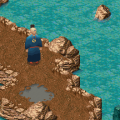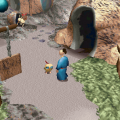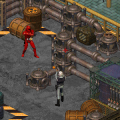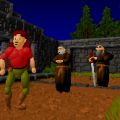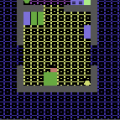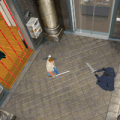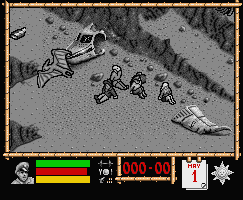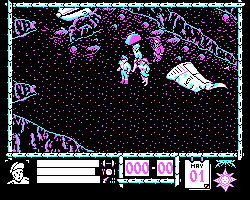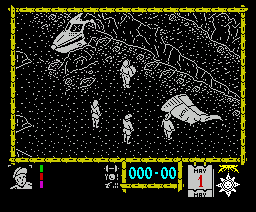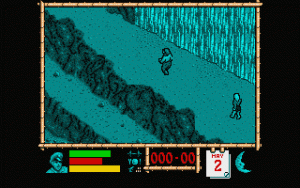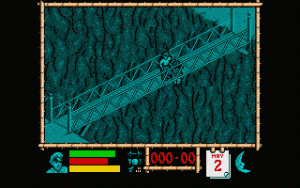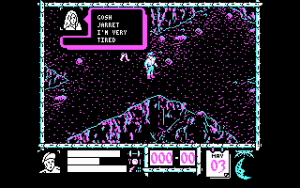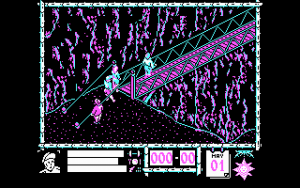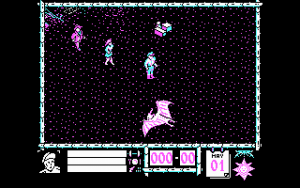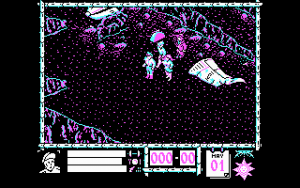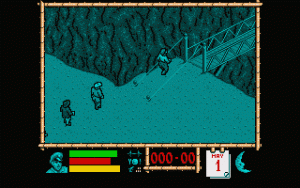by Larry Bundy Jr.
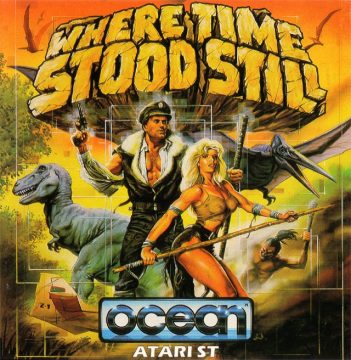
European Atari ST Cover
As much as an oxymoron as it is, survival horror as a genre has been established in video games for well over two decades now. The genre’s creation is popularly attributed to Infogrames’ 1992 release, Alone in the Dark and later on to the seminal walking-into-walls-with-zombies simulator, Resident Evil. But the overall premise of survival horror has been around in gaming long before. Arguably the very first ever example is Sinclair ZX81 title, 3D Monster Maze, released in 1982, the epic story about a clown inviting you into a maze inhabited by a rather unintimidating dinosaur. It also spawned a pseudo sequel slash remake on the spectrum where you’re chased by a three legged humpty dumpty instead. There was even a renaissance in early horror games released in other countries a few years later, such as Capcom’s fantastic Japanese only Sweet Home for the Famicom, which in turn was partially the inspiration of Resident Evil itself. Probably deemed too slow and gory for the West, it sadly languished in the gaming ether for years until a band of translators made it playable in English.
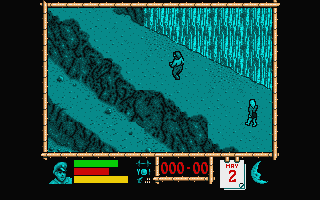
Where Time Stood Still (Atari ST)
But there was one game that encapsulated all of what made Sweet Home so fascinating, and was even made a year prior. In fact, it innovated a lot of elements that have been wrongly accredited to other video games over the years. This game is one of the most overlooked survival horror game titles of all time, Where Time Stood Still.
Where Time Stood Still was the brainchild of Liverpudlian developer, Denton Designs, a company created by ex-employees of the then recently bankrupted Imagine software. After their formation, Denton initially started out producing games for Ocean based on licenses such as Transformers, Roland Rat and Frankie Goes To Hollywood. But one of their most popular releases was an isometric adventure game based on the Steve McQueen & Richard Attenborough movie, The Great Escape. But after its commercial success and with demands of a sequel, Denton used The Great Escape as a template and then set about creating something totally unique and different to any game ever seen before.
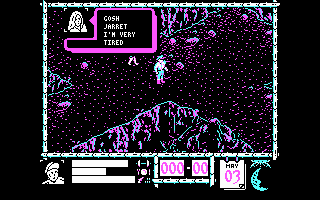
Where Time Stood Still (IBM PC)
Now Denton’s staff were by no means new to creating something unique, after all they had been the ones that had been developing the legendary vaporwares Psyclapse and Bandersnatch for Imagine before they declared bankruptcy, games coined as “mega games” – in other words, games developed that were so demanding of their platform’s processing powers, that they would need to be bundled with additional hardware just to even play them! Like the 32X, ’80s style!
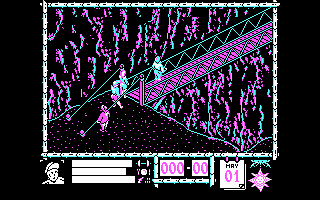
Where Time Stood Still (IBM PC)
Where Time Stood Still is heavily Inspired by Sir Arthur Conan Doyle’s The Lost World and Edgar Rice Burrough’s The Land That Time Forgot. You play as Jarrett, a guide and aeroplane pilot who has crashed onto a plateau uninhabited by man for millions of years. He’s joined by newlyweds Gloria and Dirk as well as Clive, a rag tag band of survivors who can either help or hinder your progress. It was released on the 128k version of the ZX Spectrum, PC and the Atari ST.
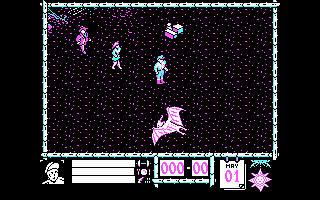
Where Time Stood Still (IBM PC)
The object of the game is to make it through with your crew alive to a mountain pass far on the other side of the plateau, Of course, this is no walk in the park, er, plateau to get from A to B, the huge landscape is covered in T-Rexes, Pterodactyls and racially stereotyped cannibals. It’s also the only video game in history where you can be killed by a rather perturbed armadillo as well!
Amazingly for its time, the three other characters each have their own personality and abilities. Dirk being the strongest of the group and has the ability to talk to natives, while Gloria is the one that likes to keep her head down, so you least need to tend to for tiredness and hunger. Clive, on the other hand, is the stereotypical “out for himself” character, the type that end up suffering some kind of ironic, grizzly death from their own personal greed in movies. While he’s the richest and can use his assets to trade with the natives for food and weapons, greed can get the better of him and he’ll occasionally want to do his own thing. So it’s up to you if you go Lara Crofting with him to keep him alive and take a share in the riches, or just tell him where to stick it.
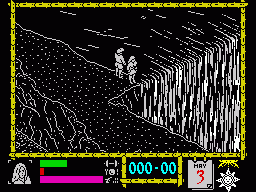
Where Time Stood Still (ZX Spectrum)
Keeping all three characters alive, while not essential, is highly advisable. For example, if Gloria dies, Dirk loses all confidence and becomes a much less useful ally, and the other way around, if Dirk dies, Gloria will literally mourn at his body and become uncontrollable. So you can be a heartless scumbag and abandon her in this state, or you can use the time to restock, searching for items or trading at the local village and return to her later on when she has finished grieving.
Clive seems to be the one no one really gives a damn about, mainly due to his selfish attitude, as well as him constantly complaining about being hungry, so he’s the least of your concerns, as long as you avoid villages, who will take offense to you entering without offering some kind of gift. You can still complete the game missing one, or even all the other flight members, but it makes the task much more difficult.
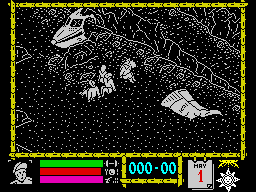
Where Time Stood Still (ZX Spectrum)
Each of the four characters also has three meters you need to observe too – one for strength, one for hunger and one for ammunition – which dictates their morale. If you ignore your teams tiredness, and not let them rest at night, they’ll become sluggish and eventually fall asleep in the most dangerous of places, and the food meter dropping will make them unresponsive, to the point they’ll give up on the team and go their own way. So monitoring the team’s morale is almost as important as keeping them alive!
But one of the most unique things about Where Time Stood Still, is each time you play it’s entirely random . And it’s not the namby pamby randomization you get in most other video games where they just place items in different areas, the entire game is unexpected.
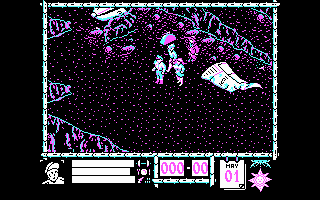
Where Time Stood Still (IBM PC)
You can play the game one time and not encounter any dinosaurs, nor cannibals whatsoever, and another time one of your party can be instantly killed by rampaging T-Rex or a pterodactyl from out of nowhere. Also, depending on how hungry and/or tired your party is, they can decimate the entire team. Even a rope bridge you’ve crossed countless times in previous games will suddenly break under the weight of one of your party members.
You can see why later games abandoned total randomness in their playthroughs as it could be considered unfair, as any video game should rely on skill to beat it, never luck. But the sole fact it will constantly keep you on your feet anticipating the unexpected does make the game that so much more tense.
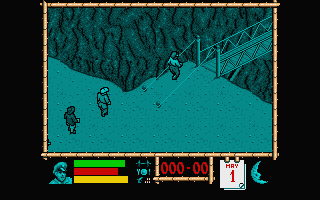
Where Time Stood Still (Atari ST)
But what did the 1988 gaming press think of Where Time Stood Still at the, erm, time? Sinclair User absolutely loved the game, giving it a whopping 96%, one of their highest ever rated games. They stated “lock yourself in your room and prepare to play the most exciting game you’ve ever seen on your Spectrum”. ACE gave it the usual nonsensical score of 710 out of 1000, but were thoughtful enough to also add a handy line graph indicating that we might not enjoy it as much if we play it constantly for an entire year. Then they summarized with the line “a game you’ll enjoy playing – until you complete it.” Their powers of observation were indeed most astounding. And Computer and Video Games got the entire name of the game wrong, and then proceed to maintain their journalistic professionalism by littering the review with general racism and rape jokes. Then gave it 8 out of 10. Classy CVG, classy.
So what happened to Denton Designs? Well, Where Time Stood Still was already a spiritual sequel to their copyright dubious, but critically acclaimed World War II action game The Great Escape. So they tried to make one more game in the “trilogy” with Wreckers. Which was similar in tone to Where Time Stood Still, just heavily inspired by the Alien franchise this time and set on an abandoned space station. 8 and 16 bit ports were developed and completed (and even reviewed by magazines), but sadly only the 16 bit versions were ever released. Denton went on to make a couple of other games, namely an Amiga port of Batman Returns and a couple of sports games, before being absorbed by Rage software to develop games for the Gizmondo. And we all know how well that turned out for them! So not quite the glorious ending for such an amazing development team.
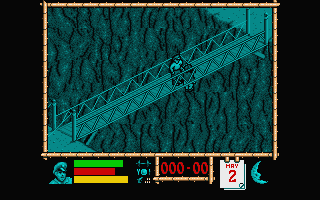
Where Time Stood Still (Atari ST)
It’s a shame that Where Time Stood Still was never awarded the attention is so rightly deserved. But it always had the odds stacked against it. Aside from it only ever being released in the UK, Germany and Spain, anyway. Denton Designs’ love for memory hungry video games from their Imagine Software days made Where Time Stood Still a whopping 128k and the inability to make it a multi-loader due to the game being one massive map, made it virtually impossible to port to the Commodore 64 and Amstrad CPC (which were only 64k each). Denton had suggested to Ocean Software, (WTSS’ publisher) to port the game to the Commodore 128 and Amstrad CPC 6128 (which did have 128k of memory) but the ultra limited user base of both computers at the time made Ocean reluctant to port anything to them, so were ultimately cancelled. There were urban legends for years of a prototype Commodore 64 port floating out there in the either, but has since been confirmed by ex-staff that it was never even started.
In 2014, an Amiga version was released by fan developers. But rather than a straight up “port”, the game is actually the Atari ST version being converted to the Amiga in real time, some really clever programming. They also added some excellent remixes of the game’s soundtrack to boot.
Despite Where Time Stood Still‘s obscurity, it’s still an extremely innovative game. The Lost World-esque setting alone is a hugely untapped environment for video games, even all these decades later and the more you play, the more you think to yourself “oh, that’s a bit like the game XXXXX” only to remember it wasn’t released until years later. Survival horror fans will absolutely love this excellent early title into what would become an established genre as it has quite a few innovative concepts that would be largely forgotten until later generations games “re-invented” them. But, for whatever way you look at it, maybe Alone In The Dark‘s mantle of being the “first modern survival horror game”, needs to be pushed back just a little more.
Links:
Hall of Light Forum – Download link for the Amiga port.

